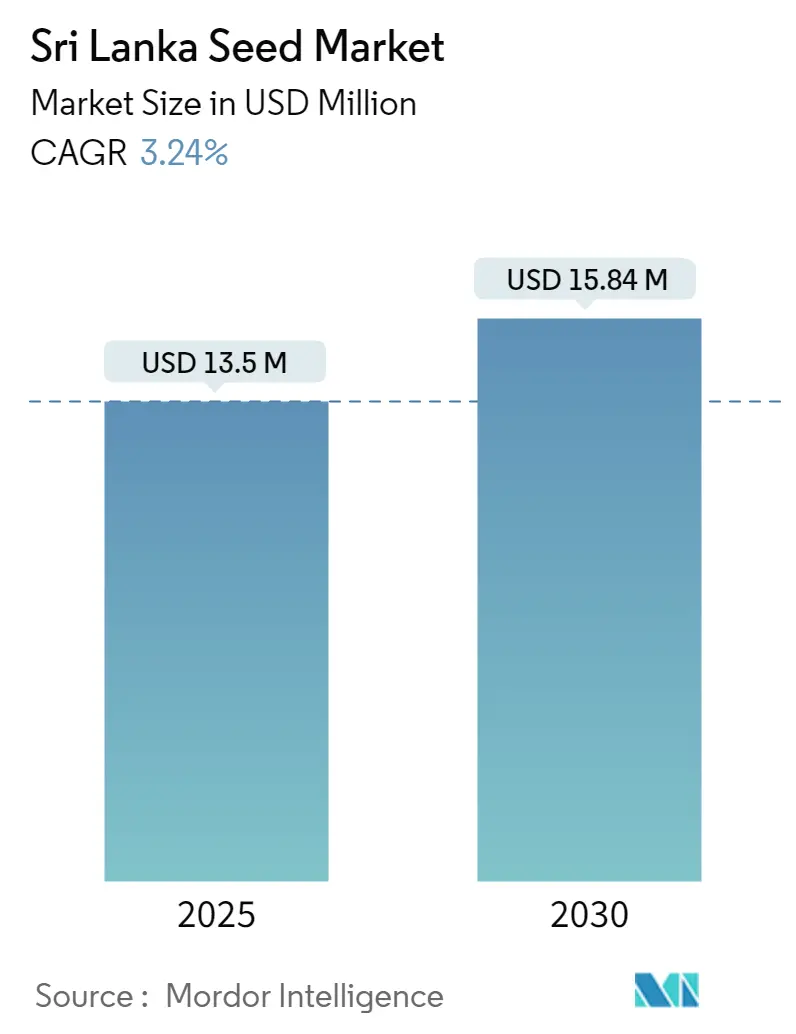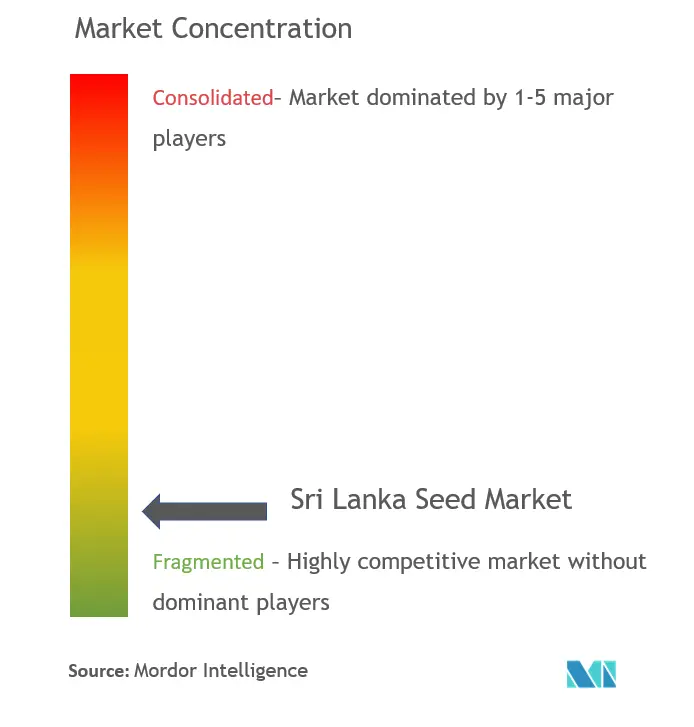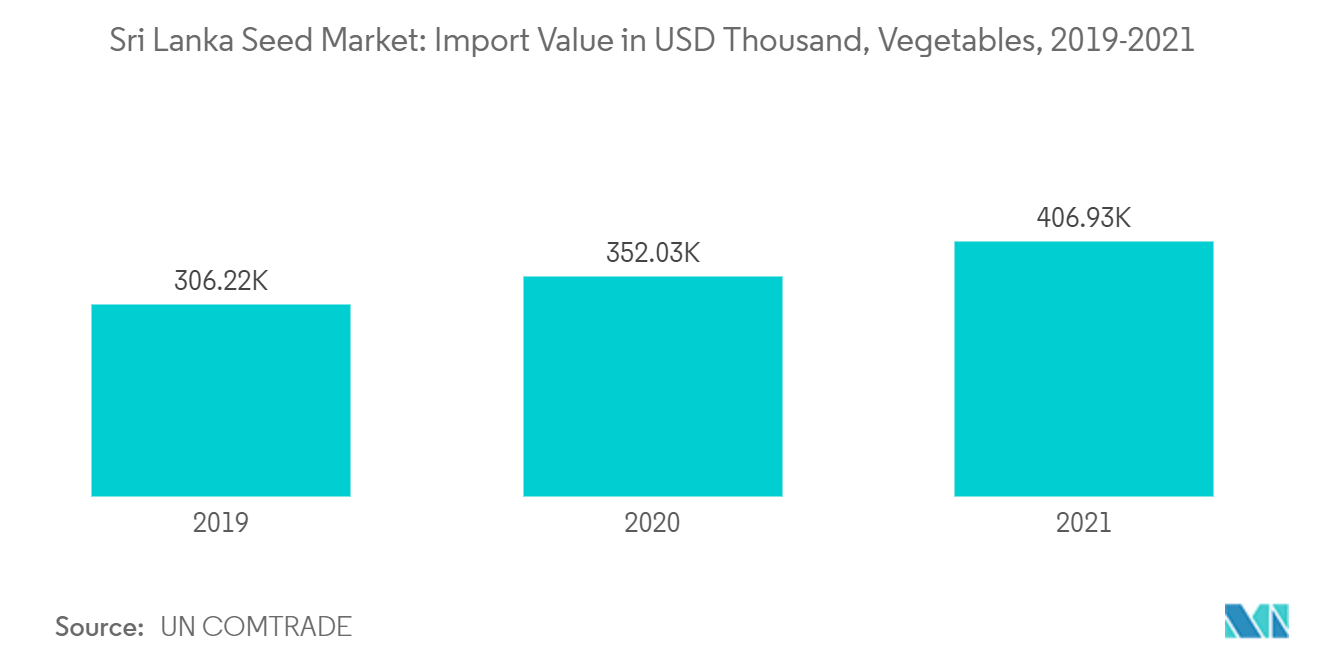
| Study Period | 2019 - 2030 |
| Base Year For Estimation | 2024 |
| Forecast Data Period | 2025 - 2030 |
| Market Size (2025) | USD 13.50 Million |
| Market Size (2030) | USD 15.84 Million |
| CAGR (2025 - 2030) | 3.24 % |
| Market Concentration | Low |
Major Players
*Disclaimer: Major Players sorted in no particular order |
Sri Lanka Seed Market Analysis
The Sri Lanka Seed Market size is estimated at USD 13.50 million in 2025, and is expected to reach USD 15.84 million by 2030, at a CAGR of 3.24% during the forecast period (2025-2030).
- In Sri Lanka, seed production activities are dominated by the public sector, notably the Department of Agriculture's Seed and Planting Material Development Centre. Most of the quality seed in the country is imported and distributed to farmers by the private sector. As Sri Lanka is dependent to a large extent on imported seed, in the past year, the Department of Agriculture and Lal Teer Seed of Bangladesh implemented a project to increase vegetable seed production in the country. Furthermore, the country has chosen a sui generis system for plant variety protection.More and more, it's important to protect the rights of plant breeders with good laws, which would encourage more private companies to get involved.
- Moreover, the increasing production of cereal crops and vegetables in the country and the growth in the area under harvest of these crops have resulted in the growth of the market and hence driven the market forward in the country.
- According to the Food and Agriculture Organization Corporate Statistical Database, the cereal production in the country has increased by 12.3% in 2020, reaching 5.4 million metric tons, and the area under harvest has increased by 12.1%, accounting for 1.1 million hectares in 2020. Similarly, the country's vegetable production volume was 1.3 million metric tons during the same year, which was an increase of nearly 50% from the previous year. Variation in cereal and vegetable production necessitated the use of quality seed to ensure consistent production and productivity.
Sri Lanka Seed Market Trends
Growth Potential of the Vegetable Sector
The demand for vegetable seeds, especially in developing countries such as Sri Lanka, is still untapped and provides multinational corporations with various opportunities for expansion and a wide customer base. Countries are shifting toward adopting high-quality seeds due to the export potential of vegetable seeds on the global market. Most companies concentrate on hybrid vegetable seeds, largely backed by patents in this region. Most vegetable seeds are consumed and produced domestically.
Sri Lanka grows manifold vegetable varieties for domestic consumption and export purposes. Locally, vegetables are of central importance in the agriculture industry as they become a vital side dish to rice-based diets, a staple in Sri Lanka. Benefitting from the diverse agro-climate conditions of various regions, Sri Lanka grows numerous varieties of vegetable crops (around 40 species) in different parts of the country throughout the year. Subsequently, traditional cropping systems are now rarely spotted in Sri Lanka, and the majority of the vegetable production comes from commercial cultivations that utilize certified seeds.
In addition, the country is a net importer of vegetables. Vegetable imports into the country have increased by 15% in 2021, according to UN Comtrade. Sri Lanka, on the other hand, has been supplying a variety of vegetables to the world due to its suitable tropical climate and geography that suit a variety of agricultural crops. On top of Sri Lanka's climatic advantage, the fertile soils, the conventional wisdom handed down from generation to generation, the established agricultural facilities, irrigation systems, and distributed rainfall patterns are quite conducive to the cultivation of such crops. Therefore, the use of improved varieties of seeds in the sector could improve the net production of several vegetables and thus decrease the dependence on imports.
Rice Dominates the Cereals Market
Cereals have been an important part of the Sri Lankan diet. Rice, millet, maize, and sorghum are some of the cereal crops grown in Sri Lanka. Further, rice is the staple food of the vast majority of Sri Lankans, and at least two meals out of the three main meals consist of rice and curry. According to the Department of Agriculture, the rice crop occupies nearly 24% of the cultivable land, with the per capita consumption of rice standing at 114 kg per year and providing a livelihood for 1.8 million farmer families island-wide.
Further, rice production has increased in the country over the years. Yala and Maha are the two major rice production seasons in the country. According to the Department of Census and Statistics in Sri Lanka, the net paddy production was 4,710,211 metric tons in the country. According to the Department of Census and Statistics in Sri Lanka, the net paddy production was 4,710,211 metric tons in 2021, and the availability of raw rice was around 3,202,944 metric tons, including post-harvest loss for human consumption as food, beverages, and other industrial usages. The average yield is highest in the Hambantota district for both seasons, and the main reason is that the seed varieties (especially AT 362), which have been developed at the Ambalantota Paddy Research Institute, have been used for the cultivation. Additionally, the government of Sri Lanka (GOSL) and health authorities actively encourage rice consumption over wheat consumption. Red rice is gaining popularity as its grain and bran become recognized for their better nutritional qualities since they are rich in vitamin B, minerals, protein, fat, and fiber. With the ever-increasing demand for rice in the country in terms of domestic demand as well as exports, rice seeds play a key role in the Sri Lanka seed market.

Sri Lanka Seed Industry Overview
The Sri Lankan seed market is fragmented, with the presence of a large number of local players marketing certified seeds. The major players in the market are Tropical Seeds/OPEX Holdings, CIC Agri-Business, Hayleys Agriculture, Plantchem Pvt Ltd (Plant Seeds Private Limited), and Advanta Seeds. These major players are investing in new products and improvisation of products, expansions, and acquisitions for business expansions. Another major area of investment is the focus on R&D to launch new products at lower prices.
Sri Lanka Seed Market Leaders
-
Tropical Seeds/OPEX Holdings
-
CIC Agri Business
-
Hayleys Agriculture Holding Limited.
-
Plantchem Pvt. Ltd.(Plant Seeds Private Limited)
-
Advanta Seeds
- *Disclaimer: Major Players sorted in no particular order

Sri Lanka Seed Market News
- September 2022: Japan International Cooperation Agency (JICA) partnered with the United Nations Development Programme (UNDP) in Sri Lanka to procure 200 metric ton of maize seeds for the maha season.
- March 2021: CIC Agribusiness launched Hybrid seed Chilli (MICH HY1) at Kothmale, resulting in high growth and high vigor with a new type of polytunnel introduced by the envirodome system from Isreal.
Sri Lanka Seed Industry Segmentation
A seed is the unit of reproduction of a flowering plant, capable of developing into another such plant. For the purpose of this report, the seeds used for sowing have been considered for market estimations and forecasts. The market does not include seeds used for human or animal consumption. The Sri Lanka Seed Market is Segmented by Product Type (Hybrid (Transgenic and Non-Transgenic) and Open Pollinated), Crop Type (Grains and Cereals (Rice, Maize, Soybean, and Other Crop Types), and Vegetables (Tomatoes, Pumpkin, Squash and Gourd, Chillies and Peppers and Other Vegetables). The report offers market estimation and forecast in value (USD million) and volume (Metric Ton) for the above-mentioned segments.
| Product | Hybrid | Transgenic | |
| Non-Transgenic | |||
| Open Pollinated | |||
| Crop Type | Grains & Cereals | Rice | |
| Maize | |||
| Soybean | |||
| Other Crop Types | |||
| Vegetables | Tomatoes | ||
| Pumpkin, Squash, and Gourd | |||
| Chillies and Peppers | |||
| Other Vegetables | |||
Sri Lanka Seed Market Research FAQs
How big is the Sri Lanka Seed Market?
The Sri Lanka Seed Market size is expected to reach USD 13.50 million in 2025 and grow at a CAGR of 3.24% to reach USD 15.84 million by 2030.
What is the current Sri Lanka Seed Market size?
In 2025, the Sri Lanka Seed Market size is expected to reach USD 13.50 million.
Who are the key players in Sri Lanka Seed Market?
Tropical Seeds/OPEX Holdings, CIC Agri Business, Hayleys Agriculture Holding Limited., Plantchem Pvt. Ltd.(Plant Seeds Private Limited) and Advanta Seeds are the major companies operating in the Sri Lanka Seed Market.
What years does this Sri Lanka Seed Market cover, and what was the market size in 2024?
In 2024, the Sri Lanka Seed Market size was estimated at USD 13.06 million. The report covers the Sri Lanka Seed Market historical market size for years: 2019, 2020, 2021, 2022, 2023 and 2024. The report also forecasts the Sri Lanka Seed Market size for years: 2025, 2026, 2027, 2028, 2029 and 2030.
Our Best Selling Reports
Seed in Sri Lanka Industry Report
Statistics for the 2025 Sri Lanka Seed market share, size and revenue growth rate, created by Mordor Intelligence™ Industry Reports. Sri Lanka Seed analysis includes a market forecast outlook for 2025 to 2030 and historical overview. Get a sample of this industry analysis as a free report PDF download.





